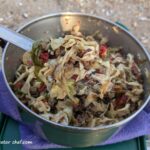Today, we are making dehydrated ground beef and cabbage. This comfort food recipe is filling, really tasty, easy to make, and it rehydrates well.
Using our Dehydrator Chef approach, we have dehydrated all of the ingredients in advance to build out our recipe. The ingredients have all been optimized to reconstitute in a reasonable period. So, you’ll have a hot, satisfying meal in less than 30 minutes out in the field or at the campsite.
So, let’s get started.
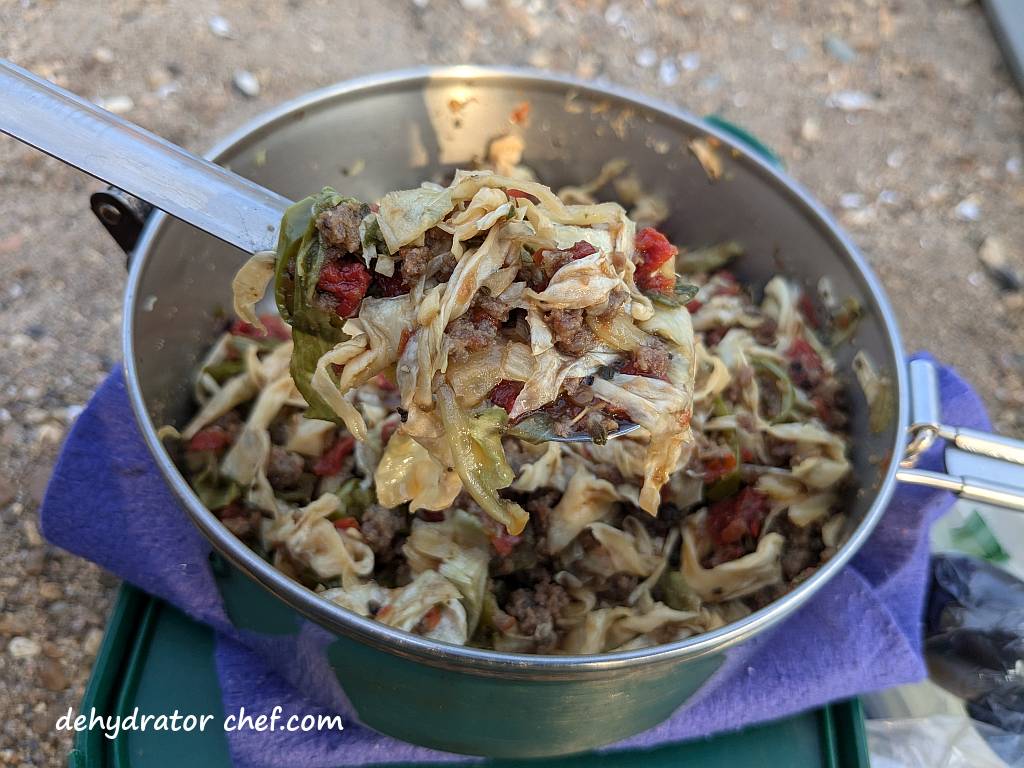
Table of Contents
- Dehydrated Ground Beef and Cabbage Recipe
- Supplies and Tools needed for this Dehydrated Camping Meal Recipe
- Dry Ingredients
- Dehydrated Ground Beef and Cabbage Wet Ingredients
- Ingredient Notes
- At-Home Preparation
- In the Field Preparation
- Dehydrated Ground Beef and Cabbage Nutrition Information
Dehydrated Ground Beef and Cabbage Recipe
Our ground beef and cabbage recipe is a filling camping comfort food. We use ingredients that are easy to source, and you can dehydrate at home yourself.
This recipe is also a great meal option for individuals interested in emergency preparedness and self-sufficiency and might find dry food recipes a helpful alternative to other expensive options.
This ground beef and cabbage recipe is a great meal option for those interested in emergency preparedness and self-sufficiency. Some people might find dehydrated food recipes to be a helpful and more affordable alternative to expensive options like freeze-dried food. However, it’s important to note that freeze-dried food will last much longer in storage compared to dehydrated food.
Supplies and Tools needed for this Dehydrated Camping Meal Recipe
Supplies and tools are minimal for making our dehydrated ground beef and cabbage, and nothing special or out of the ordinary is needed.
- Several 1-quart zip-top bags
- Heavy-duty paper towels
- Labeling material (masking tape and a waterproof all-weather pen)
- Small food-safe leak-proof container (optional)
Dry Ingredients
This recipe makes one serving approximately 150 grams of dry mix. Of course, you can adjust the ingredients as you wish.
- 45 grams dehydrated ground beef crumbles
- 15 grams dehydrated onion
- 30 grams dehydrated cabbage
- 15 grams dehydrated RoTel Diced Tomatoes with Green Chilies
- 1 teaspoon Italian seasoning
- 1/2 teaspoon garlic powder
- 1/2 teaspoon freshly ground black pepper
- 1/2 teaspoon crushed red pepper flakes
- 3 grams dehydrated chipotle peppers in adobo sauce (optional)
- 5 grams dehydrated jalapeno pepper slices (optional)
- 1 tablespoon bouillon powder (optional)

1) Dehydrated onions
2) Dehydrated ground beef crumbles
3) Dehydrated cabbage
4) Dehydrated jalapeno pepper slices (optional)
5) Dehydrated RoTel Diced Tomatoes with Green Chilies and chipotle peppers in adobo sauce
6) Spices
7) Dehydrated bouillon powder (optional)
Dehydrated Ground Beef and Cabbage Wet Ingredients
- A quality oil, such as avocado or olive oil, in a leak-proof container (optional)
Ingredient Notes
We recommend making and then trying this homemade dehydrated camping meal recipe several times at home before preparing it for the first time in the field so you will know what to expect. Armed with this experience, you can dial in the spices how you like and add or subtract any of the other ingredients. Don’t depend on untested gear or untested recipes.
At-Home Preparation
Combine all the dry ingredients into a single food-safe 1-quart quality name-brand zip-top bag for the best storage results. The sharp edges of dehydrated ingredients may cause micro-punctures in lesser-quality zip-top plastic bags.
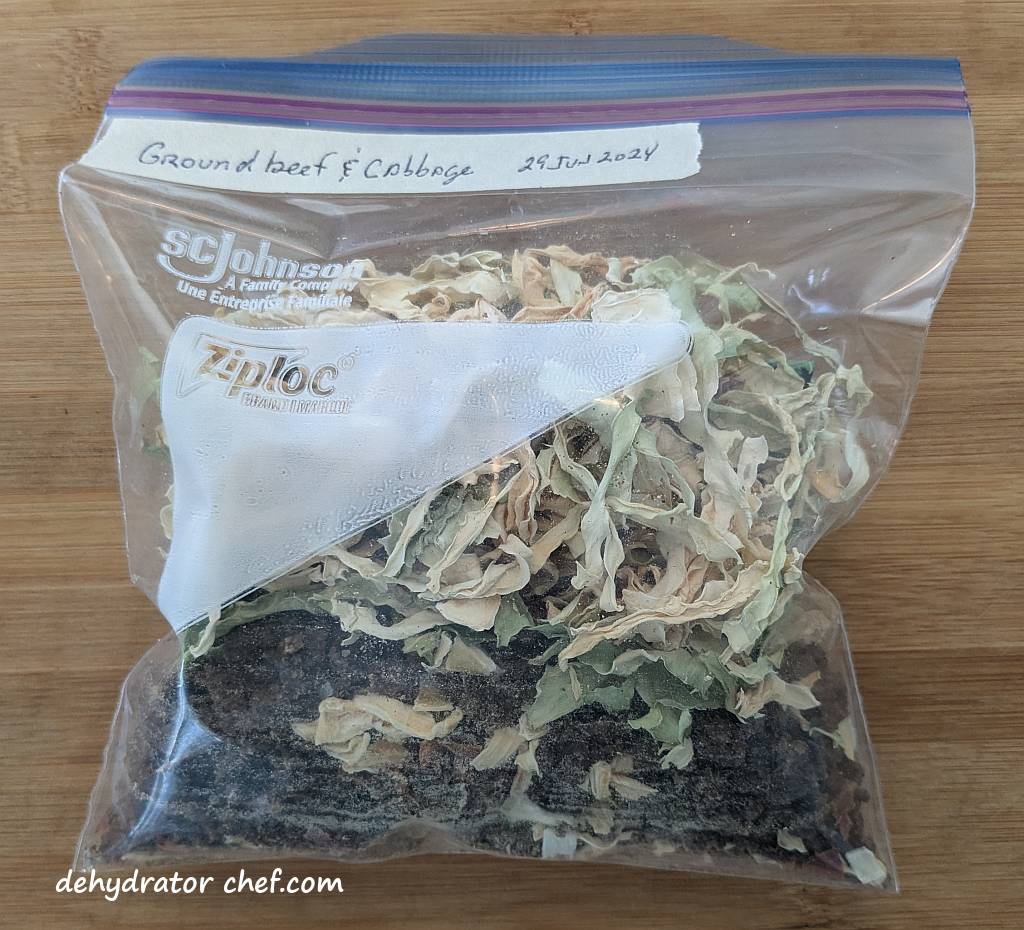
For added durability, double bagging, using two zip-top bags with a separator, is an option that helps guard against punctures, leaks, and water penetration and protects the food’s integrity. Hence, it remains viable in the field or pantry storage.

These heavy-duty paper towels have over 11,000 Amazon customer reviews with an average rating of 4.8 out of 5 stars, which is evidence of a great product. You may be able to find them at your local big-box megamart automotive department.
The Scott Shop towels brand makes an excellent bag separator. These multipurpose paper towels are thicker than the average heavy-duty paper towel. As a multitasker, repurpose these towels for the after-meal cleanup activities.
Compared to the local big box stores, Amazon has the best prices for the Ziploc 1-quart zip-top bags. So says the 20,000 plus Amazon customer reviewers who took the time to leave feedback. The rough edges and sharp ends of dehydrated foods very often compromise generic zip-top bags. Quality zip-top bags are a necessity when making dehydrated meals for camping.
Need another reason to buy quality name-brand Ziploc bags? An analysis commissioned by the Mamavation website showed that the majority of plastic sandwich bags sold in the U.S. contain high levels of toxic PFAS, also known as forever chemicals. Ziploc was one brand that contained no detectable levels of forever chemicals.
Be sure to include a short note with the name of the dish and detailed preparation instructions. This homemade dehydrated camping meal will look just like all others in your pack. We have included printable and detailed preparation instructions near the end of this page.
A bit of healthy cooking fat, such as olive or avocado oil added to the meal after cooking will significantly enhance the flavor. Fats concentrate the flavors in food. It gives the food a smooth and creamy texture that many of us crave. Since fat gives us more energy than proteins or carbohydrates, it makes us feel full faster, and it makes us feel content. Proteins and carbohydrates provide about four calories per gram, while fats provide nine calories per gram. From the perspective of hungry hikers and campers, fat is definitely on the menu.
In the Field Preparation
Empty the contents of the zip-top bag into a suitable-sized cooking pot.
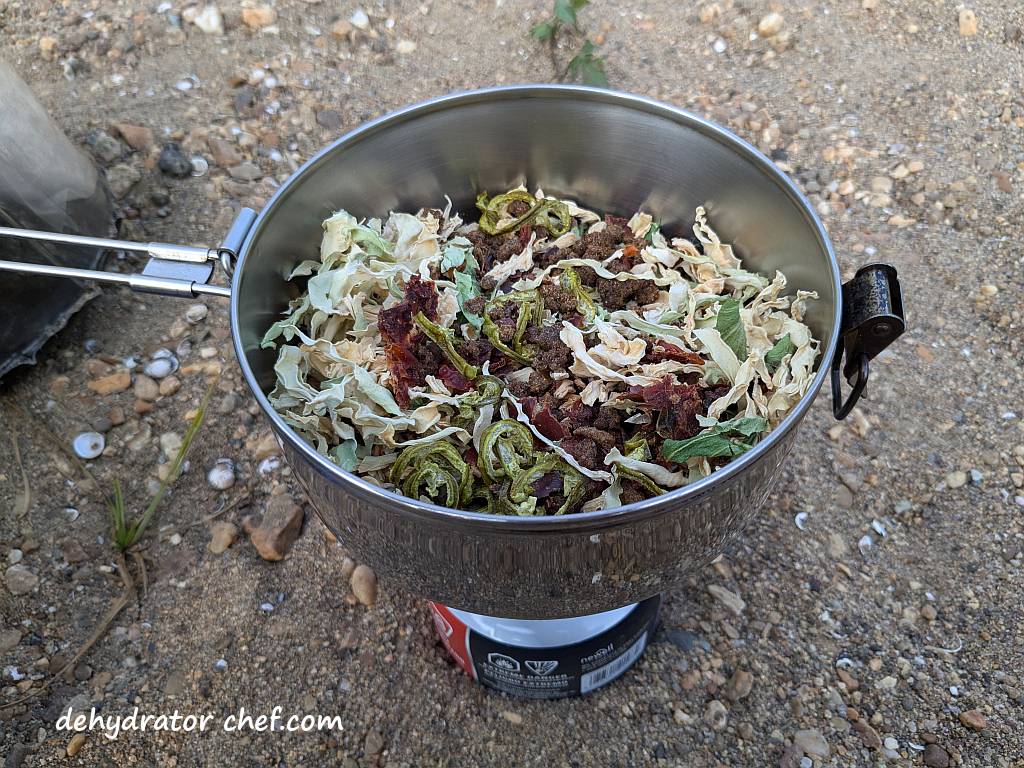
Measure in enough water to cover the dry ingredients. Then add a tad bit more water. Stir to mix thoroughly. Cover, and let the dry ingredients hydrate for several minutes. Stir several times, and add more water if needed to keep all ingredients covered and well-saturated with water.
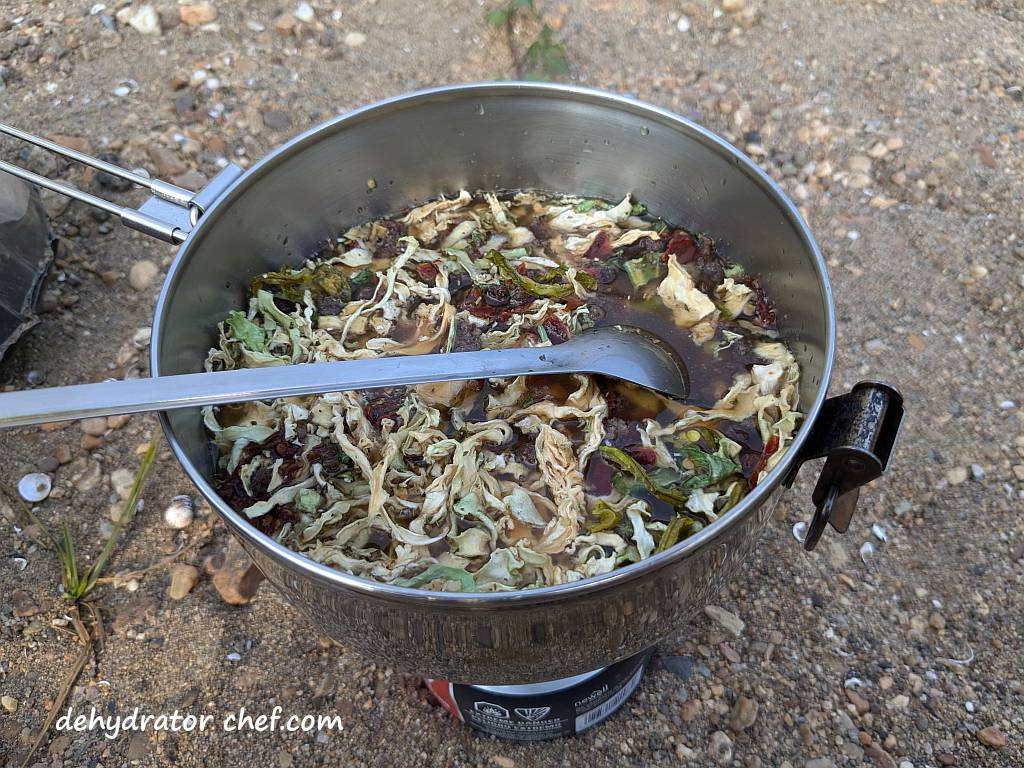
I’ll go with a minimum of 5 minutes of soaking time to allow the dry ingredients to reconstitute. Five minutes is a good rule of thumb for our collection of Dehydrator Chef recipes.
So why not add all the water at once? You certainly can, but we are metering in the water, so we don’t end up with a too-dry or a too-soupy product. Adding water in smaller amounts seems to work best for our Dehydrator Chef recipes.
One last thing: a little too much water is better than not enough water. Sure, dinner might be a little bit soupy; however, soupy is better than hard and crunchy. Lastly, soupy helps prevent burning. So, no worries here.
Next, on your cooking stove and over medium flame, bring the hydrating mix to a boil, frequently stirring frequently to mix. After coming to a boil, if your stove is capable of a low-heat simmer, turn the flame down to reduce the chance of burning.

After simmering for at least two minutes while stirring and mixing the ingredients, turn off the stove. Then, transfer the pot into an insulated wrap or cozy. Let it rest, hydrate, and steam for an additional 15 to 20 minutes. This will allow the flavors to blend and the ingredients to fully reconstitute.

Practice these Dehydrator Chef homemade dehydrated camping meal recipes at home several times with the very same outdoor kitchen gear used in the field or at the campsite. This approach lets you practice your skills to know what to expect and where to adapt.
Dehydrated Ground Beef and Cabbage Nutrition Information
Nutrition information is only an estimate. The nutrition information of this recipe may differ depending on the ingredients you use.
Approximate Serving Size: 150 grams | Calories: 575kcal | Total Fat: 10g, | Saturated Fat: 4g | Cholesterol: 78mg | Sodium: 363mg | Carbohydrate: 87g | Dietary Fiber: 25g | Sugar: 37 g | Protein: 42g
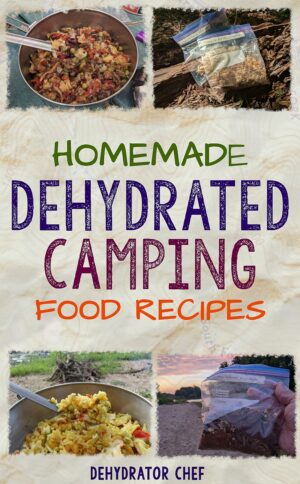 | The Dehydrator Chef Book Available only on Amazon.com You’ll find step-by-step instructions for 26 homemade dehydrated camping meals. Many recipes are only available in this book. Grab yourself a copy today. |
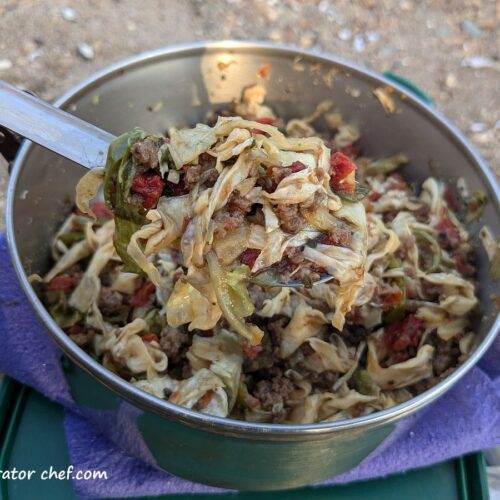
Dehydrated Ground Beef and Cabbage
Equipment
- Labeling materials (masking tape, waterproof all-weather pen)
Ingredients
Dry Ingredients
- 50 grams dehydrated ground beef crumbles
- 15 grams dehydrated onion
- 50 grams dehydrated cabbage
- 15 grams dehydrated RoTel Diced Tomatoes with Green Chilies
- 1 teaspoon Italian seasoning
- 1/2 teaspoon garlic powder
- 1/2 teaspoon freshly ground black pepper
- 1/2 teaspoon crushed red pepper flake
- 3 grams dehydrated jalapeno pepper slices (optional)
- 3 grams dehydrated chipotle peppers in adobo sauce (optional)
- 1 tablespoon bouillon powder (optional, enough for 1 cup water)
Wet Ingredients
- quality cooking oil, such as avocado or olive oil (stored in a leak-proof container)
Instructions
At Home Preparation
- Add the dry ingredients to a food-safe 1-quart quality name-brand zip-top bag. Label the zip-top with the contents and the date.50 grams dehydrated ground beef crumbles, 50 grams dehydrated cabbage, 15 grams dehydrated onion, 1 tablespoon bouillon powder, 3 grams dehydrated jalapeno pepper slices, 3 grams dehydrated chipotle peppers in adobo sauce
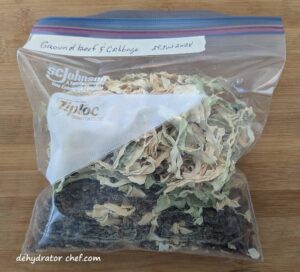
- Store the leak-proof container of cooking oil in your cooking pot or with your camp kitchen spices and condiment packets.quality cooking oil, such as avocado or olive oil
Packaging
- Wrap the zip-top bag with a heavy-duty paper towel to help guard against punctures, leaks, and water penetration due to the sharp edges of the dehydrated ingredients and to protect the food's integrity. This way, it remains viable in the field or pantry storage.
- Add the paper towel wrapped dry mix bag to the last food-safe 1-quart quality name-brand zip-top bag and label it with the contents and the date.
In the Field Preparation
- Empty the dry mix contents of the zip-top bag into a suitable-sized cooking pot.
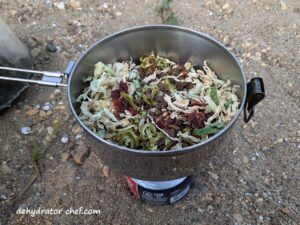
- Add enough water to cover the dry ingredients. Then add a tad bit more water. Stir to mix thoroughly. Cover, and let the dry ingredients hydrate for a minimum of five minutes.
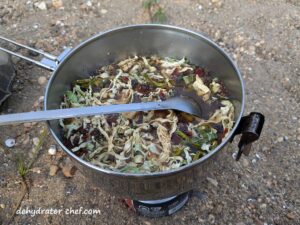
- Next, on your cooking stove and over medium flame, bring the hydrating mix to a boil, frequently stirring to mix. After coming to a boil, turn the flame down to a simmer to reduce the chance of burning.
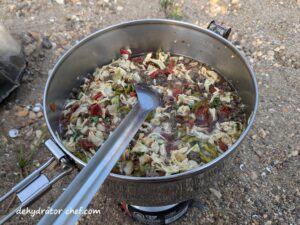
- After two or more minutes of simmering and stirring, turn off the stove and move the pot into an insulated wrap or cozy to rest, hydrate, and steam for 15 to 20 minutes or more for the flavors to blend and the ingredients to fully reconstitute.
- If desired, add a bit of the healthy cooking oil from the leak-proof container. Stir to combine.quality cooking oil, such as avocado or olive oil
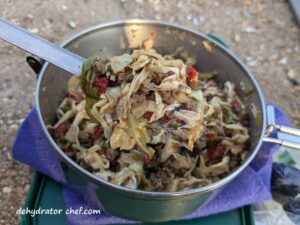
Notes
Nutrition
Nutrition information is only an estimate and may differ depending on the ingredients you use.
Dehydrated Ground Beef and Cabbage Preparation Instructions
Equipment
- camp kitchen equipment (including camping stove, cooking pot, utensils, etc.)
Materials
- 1 serving dehydrated ground beef and cabbage
Instructions
- Empty the dehydrated ground beef and cabbage dry mix contents of the zip-top bag into your cooking pot.
- Pour in enough water to cover the dry mix, then add a tad bit more.
- Cover and let the dry ingredients hydrate in your camp cookware for at least five minutes. Stir all of the way to the bottom now and again. Add more water if the hydrating mix gets too dry.
- Next, on your cooking stove and over a medium flame, bring the slurry to a boil, stirring frequently to prevent burning.
- After bringing the slurry to a boil, turn the stove down to a low simmer for two minutes.
- After two or more minutes of simmering and stirring, turn off the stove and move the pot into an insulated wrap or cozy to rest and hydrate for 15 to 20 minutes or more for the flavors to blend and the ingredients to fully reconstitute.
- Finally, after the ground beef and cabbage have rested for 15 to 20 minutes, add some of the optional cooking oil and stir to mix. Enjoy!


